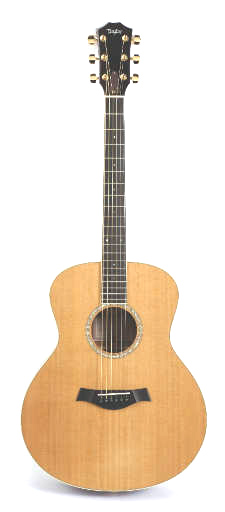MusicRadar Verdict
By today's standards, the price seems fair, and you'd have to commission a local luthier to get something equivalent for less.
Pros
- +
Lovely flame maple body panels. Sweet treble response.
Cons
- -
Again, it's not quite as adaptable as the GSRS.
MusicRadar's got your back
Following Taylor's coup last year with the T5, this year's quest was to launch a new body style that physically and sonically bridged the gap between its hugely popular grand auditoriums and its dreadnoughts and jumbos.
Taylor's answer is the Grand Symphony (GS) guitar. Conceptualised by Bob Taylor and developed by senior designers Ed Granero and Larry Breedlove (co-founder of Breedlove Guitars), the GS body takes the grand auditorium theme to the next logical step.
Slightly wider in lower bout and with a wider, higher waist than the GA, its soundbox's shape and increased proportions are designed to add depth and power, without compromising midrange and treble clarity.
The basic GS Series comprises four identically constructed, purely acoustic models with virtually identical cosmetics, offering four different tonewood combinations.
You may notice the rosewood/spruce review model we were supplied with has the Expression System option, but we're only discussing the guitar itself here.
Taylor has purposely separated the exclusively non-cutaway GS Series from its established, numerically coded range in order to distance them from the 'cutaway electro' theme that permeates the standard catalogue.
With generally understated appointments and one set price for all models, the idea is that you choose a GS purely for its specific tonal qualities, rather than the fact that one has fancier inlays or other features.
Overview
As you'll see, from the front you can't tell this one apart from the GSRS. Spin it round, though, and you'll delight in the striking flame (aka fiddleback) figure in the Big Leaf maple back and side panels, made more pronounced by the rich, golden, honey stain.
It almost looks like koa, and the neck is stained to match. The back and sides also have the thin black perimeter seams and back strip. In use, the only difference is the gloss-finish neck, which, like all gloss-neck Taylors, exhibits a lovely, buttery feel and is far more pleasant to move around on than a fresh nitro gloss neck.
Matt-satin finishes may be 'faster', but they need maintenance to preserve that low-lustre surface.
Sound
Compared to the rosewood/ spruce model, this guitar delivers a tighter, more focused tone. It seems quieter, which is due to the fact that its tone isn't as broad and lush, but there's a satisfyingly solid quality to both the mid-range and treble registers.
It sounds clipped at both ends of the spectrum. When you pick the top string hard high up, you get a sharp attack, but the high, scratchier overtones are damped by natural compression, making for sweet, non-pingy notes, and it's the least bright and zingy of the four models.
It's a direct 'in your face' kind of sound that's great for choppy rhythms and stabbing lead lines.
What’s the buzz? Meet Yellowjacket, Cherry Audio's recreation of EDP’s trend-setting Wasp from 1978
“A fabulous trip through all eight songs by 24 wonderful artists and remixers... way beyond anything I could have hoped for”: Robert Smith announces new Cure remix album
“He knows what I'm thinking and feeling before I even know it": Billie Eilish suggests that she and brother Finneas can read each other's minds










